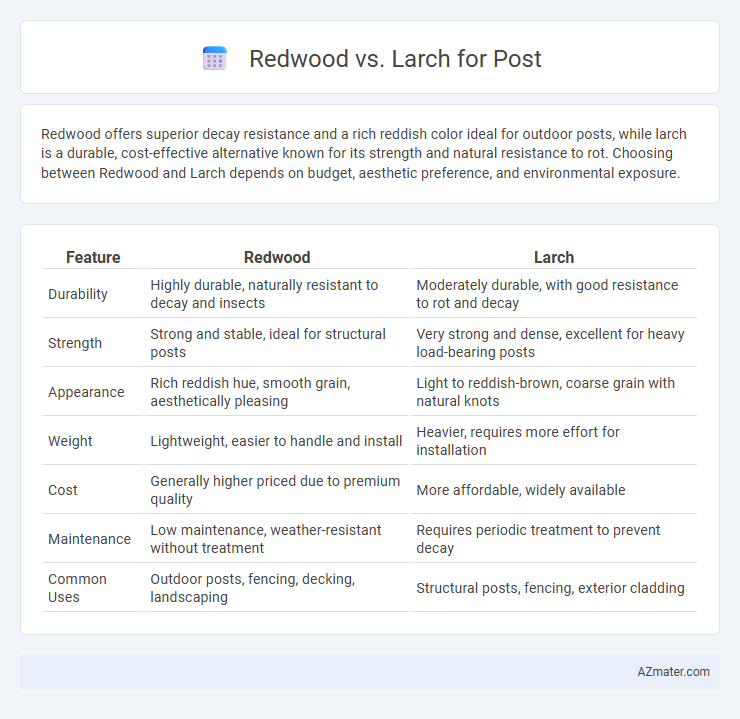Redwood offers superior decay resistance and a rich reddish color ideal for outdoor posts, while larch is a durable, cost-effective alternative known for its strength and natural resistance to rot. Choosing between Redwood and Larch depends on budget, aesthetic preference, and environmental exposure.
Table of Comparison
| Feature | Redwood | Larch |
|---|---|---|
| Durability | Highly durable, naturally resistant to decay and insects | Moderately durable, with good resistance to rot and decay |
| Strength | Strong and stable, ideal for structural posts | Very strong and dense, excellent for heavy load-bearing posts |
| Appearance | Rich reddish hue, smooth grain, aesthetically pleasing | Light to reddish-brown, coarse grain with natural knots |
| Weight | Lightweight, easier to handle and install | Heavier, requires more effort for installation |
| Cost | Generally higher priced due to premium quality | More affordable, widely available |
| Maintenance | Low maintenance, weather-resistant without treatment | Requires periodic treatment to prevent decay |
| Common Uses | Outdoor posts, fencing, decking, landscaping | Structural posts, fencing, exterior cladding |
Introduction to Redwood and Larch
Redwood and larch are two popular timber choices for posts, each with unique characteristics suited to outdoor construction. Redwood, prized for its natural decay resistance, offers durability and a rich reddish hue, commonly used in fencing and landscaping posts. Larch, a dense softwood with high resin content, provides excellent weather resistance and strength, making it ideal for structural applications requiring robust support.
Botanical Overview: Redwood and Larch
Redwood (Sequoia sempervirens) is an evergreen conifer known for its towering height and resistance to decay, thriving in moist coastal environments with thick, fibrous bark. Larch (Larix decidua), a deciduous conifer, sheds its needles annually and exhibits strong adaptability to cold, mountainous regions with its soft, lightweight wood. Both species feature distinct botanical traits influencing their durability and aesthetic appeal when used for posts in construction.
Durability and Longevity Comparison
Redwood offers superior natural resistance to decay and insect damage, making it highly durable for outdoor posts with an average lifespan of 20-30 years when properly maintained. Larch, known for its dense resinous heartwood, provides good durability and can last 15-25 years in similar conditions but is more prone to weathering over time. Choosing redwood ensures longer-lasting structural integrity and reduced maintenance requirements compared to larch in post applications.
Resistance to Rot and Insects
Redwood offers superior resistance to rot and insects due to its high content of natural tannins and oils, making it a durable choice for outdoor posts in damp or pest-prone environments. Larch, while slightly less resistant than redwood, contains natural resins that provide good decay resistance and moderate insect deterrence, commonly used in colder climates for structural applications. Both woods perform well in terms of longevity, but redwood generally outlasts larch when exposed to harsh weather and soil conditions.
Structural Strength and Stability
Redwood offers superior structural strength with a high strength-to-weight ratio, making it ideal for posts that require durability and load-bearing capacity. Larch is known for its excellent stability and resistance to warping, swelling, and shrinking due to its dense grain and natural resin content. Choosing between Redwood and Larch depends on the specific project needs, with Redwood excelling in strength and Larch providing enhanced dimensional stability over time.
Workability and Ease of Installation
Redwood offers excellent workability due to its lightweight nature and smooth grain, allowing for easier cutting, sanding, and fastening, which simplifies installation. Larch, while harder and denser, provides superior strength but requires more effort and specialized tools for cutting and drilling, potentially complicating the installation process. Choosing redwood for posts ensures quicker handling and assembly, whereas larch demands more skilled labor and time due to its toughness.
Environmental Impact and Sustainability
Redwood posts demonstrate superior sustainability due to their natural resistance to decay, reducing the need for chemical treatments compared to larch, which often requires preservatives that can impact soil and water quality. Larch is a fast-growing species, promoting quicker forest regeneration and carbon sequestration, but its shorter lifespan results in more frequent replacements and higher long-term environmental costs. Choosing redwood minimizes environmental impact through durability and lower maintenance, while larch supports sustainable forestry practices with its rapid growth cycle.
Cost and Availability
Redwood posts generally cost more than larch due to their premium durability and natural resistance to decay, making them a long-lasting investment despite the higher initial price. Larch, being more abundant in certain regions, tends to be more readily available and budget-friendly, offering a balance between strength and affordability. Availability of redwood can be limited depending on location, whereas larch posts are commonly sourced from European and North American forests, impacting shipping costs and delivery times.
Aesthetic Differences: Color and Grain
Redwood posts exhibit a rich reddish-brown hue with a straight, uniform grain pattern, offering a warm and elegant appearance ideal for classic or rustic designs. Larch posts feature a golden-yellow to light brown color with pronounced, irregular grain that provides a more textured and natural look, perfect for contemporary or rugged aesthetics. The color stability and grain visibility in redwood tend to maintain a polished finish longer, whereas larch's vivid grain pattern enhances visual depth and character over time.
Best Applications: Choosing Redwood or Larch for Posts
Redwood offers superior natural durability and weather resistance, making it ideal for outdoor posts exposed to harsh conditions. Larch, known for its dense grain and heavy strength, is better suited for structural posts requiring high load-bearing capacity. Both woods are excellent choices, but Redwood excels in longevity for fencing and decking posts, while Larch is preferred for robust construction and utility poles.

Infographic: Redwood vs Larch for Post
 azmater.com
azmater.com